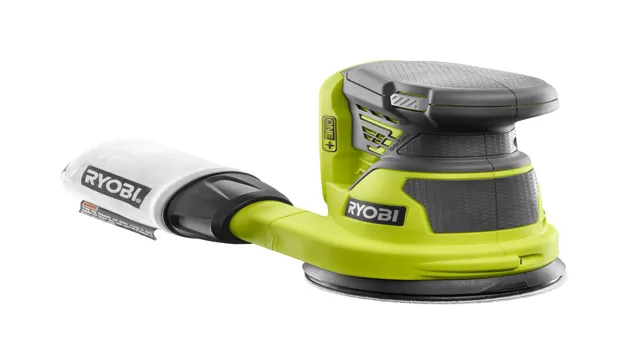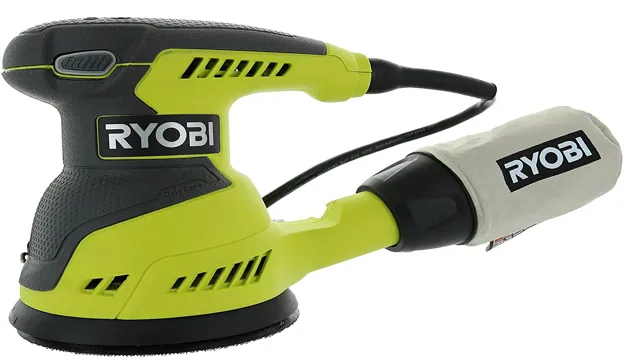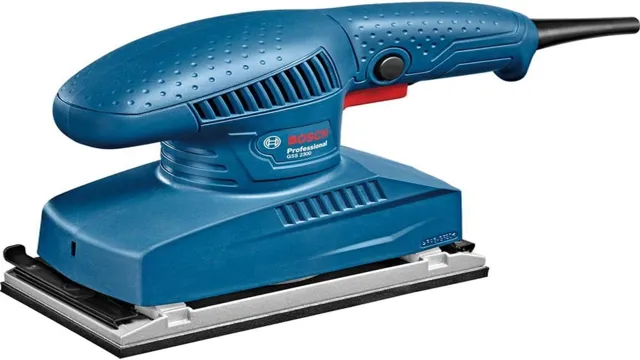
If you’re a beginner in carpentry, using a Ryobi Orbital Sander may seem like a daunting task. Even if you’re an experienced DIYer, mastering this power tool can be tricky. But fear not! With this beginner’s guide, you’ll be able to use the Ryobi Orbital Sander like a pro in no time.
This versatile sander is perfect for a range of projects, from sanding down old furniture to smoothing out a wooden surface before staining or painting. But before you begin, make sure you have all the necessary safety equipment and understand the basic principles of sanding. So, let’s dive into the world of sanding and learn how to use the Ryobi Orbital Sander to achieve a smooth and polished finish on any wooden surface.
Inspecting the Sander
Before you begin using your Ryobi orbital sander, it’s important to inspect it to ensure it’s in good condition. Start by checking the sandpaper on the sanding pad. If it’s worn or torn, replace it before use.
Inspect the pad itself, checking for any cracks or damage. Next, check the dust bag to ensure it’s securely attached and isn’t full. Empty it if necessary.
Lastly, check the power cord for any fraying or damage. If there are any issues, don’t use the sander until they’re resolved. With a properly working sander, you’ll be able to achieve smooth and even sanding on any surface.
So take the time to inspect your sander, and you’ll be rewarded with great results.
Check the sanding pad and dust bag for wear and tear
When it comes to inspecting your sander, one important element to check is the sanding pad and dust bag. Over time, these parts can become worn or torn, which can not only affect the quality of your sanding but also create a safety hazard. Before using your sander, take a few minutes to thoroughly examine the sanding pad for any signs of damage or wear, such as cracks or tears.
Additionally, inspect the dust bag for any holes or tears that could result in dust and debris escaping into the air during use. By keeping these parts in good condition, you’ll not only ensure effective sanding but also safeguard your health and safety. So remember, before you start sanding, always give your sander a quick but thorough inspection, particularly the sanding pad and dust bag.

Make sure the power cord is in good condition and properly connected to a power source
When it comes to maintaining proper safety protocols while using a power sander, inspecting the equipment before use is imperative. Start by unplugging the sander and separating all attachments to get a clear view of the tool. Make sure the power cord is in good condition and properly connected to a power source.
A frayed or damaged cord can lead to safety hazards, including electrocution. If the cord shows any signs of wear and tear or if you notice any exposed wires, replace it before using the sander. Additionally, check the on/off switch and ensure that it functions properly before use.
Remember, proactive inspection of your power sander helps prevent injuries and prolongs its lifespan. By regularly inspecting your power sander, you can maintain a safe work environment and complete your sanding projects with peace of mind.
Choosing the Right Sandpaper
If you’re wondering how to use Ryobi orbital sander, the first step is to choose the right sandpaper for the job. The grit of sandpaper you choose will depend on the material you’re sanding and the level of abrasion you need. For rough surfaces or stripping paint, you’ll want a coarse grit like 60 or 80.
For smoothing out surfaces, a medium grit like 120 or 150 will do the trick, while a fine grit like 220 is best for finishing touches. Keep in mind that the higher the grit number, the finer the abrasive particles are. When using your Ryobi orbital sander, it’s important to start with a lower grit sandpaper and work your way up to higher grits for the smoothest finish possible.
Happy sanding!
Select sandpaper with the appropriate grit for your project
When you’re sanding a surface for your project, it’s essential to choose the right sandpaper with the appropriate grit. The grit of sandpaper refers to the number of abrasive particles per square inch on the sandpaper. Generally, the higher the grit number, the finer the sandpaper.
If you’re sanding a rough surface or removing paint, you’ll want to use a lower grit, such as 60 or 80. On the other hand, if you’re looking to smooth out a surface or remove scratches, you’ll need a higher grit like 220 or 320. Remember, using the wrong grit can damage your project, so it’s essential to choose the right one.
Whether you’re working on wood, metal, or plastic, take the time to select the proper sandpaper for best results.
Attach the sandpaper to the sander’s pad, making sure it’s securely in place
When it comes to sanding, choosing the right sandpaper is crucial for ensuring a smooth finish on your project. The grit of the sandpaper determines how much material will be removed with each pass, so it’s important to select the appropriate grit for your needs. For instance, if you’re removing old paint or rough spots, a lower grit (60-80) will do the trick.
However, if you’re looking to smooth out scratches and prepare for painting or staining, a higher grit (120-220) is recommended. Once you’ve selected the proper grit, it’s time to attach it to the sander’s pad. Make sure it’s securely in place, and be sure to check periodically during use to ensure it hasn’t become loose.
Remember to always work in a well-ventilated area and wear appropriate safety gear, as sanding can produce fine dust particles that can be harmful if inhaled. By choosing the right sandpaper and taking the proper precautions, you’ll be well on your way to achieving a perfect finish on your project.
Using the Sander
Are you new to using power tools? If you’ve never used a Ryobi Orbital Sander before, it may seem daunting at first, but don’t worry, it’s actually quite simple. First, make sure you have the correct sandpaper attached to the bottom of the sander. Then plug it in and turn it on.
You’ll want to hold the sander with two hands, with one hand on the handle and the other on the front of the sander. Start by pressing the sander onto the surface you want to sand and move it back and forth in a smooth motion. Keep the sander moving and don’t let it sit in one spot for too long as it can create grooves in the surface.
If you need to sand a corner or tight spot, use the tip of the sander to get in there. Don’t press too hard on the sander, let it do the work for you. With a little bit of practice, you’ll be using your Ryobi Orbital Sander like a pro in no time.
Turn on the sander and let it reach full speed before touching the surface
When using a sander, it’s important to remember to turn it on and let it reach full speed before touching the surface. This step is crucial because it allows the sander to warm up and distribute its weight evenly across the surface, ensuring that it doesn’t leave any marks or unevenness. It also reduces the risk of the sander slipping or jumping, which can injure you or damage the wood.
Starting the sander without a load actually reduces its lifespan, so you should avoid doing so whenever possible. Once the sander has reached its full speed, you can proceed to place it on the surface and apply enough pressure to smooth out the wood. Remember to move the sander in a back-and-forth motion, keeping it in a steady rhythm to avoid creating unnecessary patterns.
By following these tips and taking your time, you can achieve a smooth surface that’s perfect for painting or staining.
Gently guide the sander over the surface in a back-and-forth or circular motion
Using a sander can be a little tricky, but with the right technique, you can achieve a smooth and even finish on any surface. One of the essential things to keep in mind is to guide the sander gently over the material in a back-and-forth or circular motion. Avoid pressing too hard as you move the sander, as this can cause unwanted scratches and unevenness.
Instead, let the tool do the work for you by applying just enough pressure to keep it in contact with the material. It’s also important to keep the sander moving at a steady pace to prevent any swirls or marks from forming in the wood or other surfaces. With practice and patience, you’ll soon get the hang of using the sander and be able to achieve a professional-looking finish on all your projects.
So, keep calm, use a light hand, and enjoy the smoothing process!
Avoid pressing down too hard on the sander to prevent damage to the surface
When it comes to using a sander, it’s important to be gentle and avoid applying too much pressure. Pressing down too hard can cause damage to surfaces such as wood or paint, leaving unsightly marks and blemishes. Instead, try using a light touch and letting the sander do the work for you.
You can also adjust the speed and pressure settings on the sander, depending on the type of surface you’re working on. If you’re unsure of the proper technique, consider watching some tutorials or taking a class to learn the best practices for sanding. Remember, sanding is a vital step in many DIY and home improvement projects, so take your time and use a gentle touch to achieve the best results.
By following these tips, you’ll be able to avoid any damage and ensure that your project turns out perfectly.
Cleaning Up
When it comes to keeping your Ryobi orbital sander clean, there are a few simple steps you can follow to ensure it stays in good working condition. Start by unplugging the sander and removing the sanding sheet. Use a soft brush or cloth to remove any debris or dust that has accumulated on the sander.
If there is stubborn buildup on the sandpaper, you can lightly tap it against a hard surface to dislodge some of the particles. It’s important to avoid using water or harsh chemicals on the sander, as this can damage the motor or other components. Once you have removed all the dust and debris, you can replace the sanding sheet and plug the sander back in.
With these simple steps, you can keep your Ryobi orbital sander running smoothly and efficiently for years to come.
Turn off the sander and unplug it from the power source
When it comes to using a sander, it’s imperative to clean up after each use to maintain the tool’s longevity and effectiveness. Start by turning off the sander and unplugging it from the power source. Once the tool is disconnected from the electricity, remove the dust bag and empty its contents.
Next, use a clean cloth to wipe down the sander and remove any excess sawdust or debris. For hard-to-reach areas, use a small brush or compressed air to blow away any remaining dust. After cleaning the tool, inspect the sandpaper for wear and tear and replace it if necessary.
Taking the time to properly clean and maintain your sander will not only prolong its life but also help you achieve a better finish on your projects.
Empty the dust bag and dispose of the debris
When it comes to cleaning up after a vacuuming session, it’s important to remember to empty the dust bag and dispose of all the debris that has collected inside. Neglecting this step can lead to foul odors and even damage to the vacuum itself. First things first, locate the dust bag and remove it from the vacuum.
Some models may have a top lid that needs to be opened, while others may require you to take apart the vacuum body. Once you have access to the dust bag, carefully remove it and dispose of the debris inside. Depending on your vacuum model and the type of debris collected, you may need to take extra precautions, such as wearing gloves or using a separate trash bag for disposal.
After you’ve emptied the dust bag, be sure to replace it securely back into the vacuum before storing it away. By properly cleaning up and disposing of debris, you’ll ensure a longer lifespan for your vacuum and a cleaner living environment for yourself and your family.
Wipe down the sander with a clean cloth and store it in a dry place
After completing your sanding project, it’s crucial to properly clean up your sander. Start by unplugging the tool and using a clean cloth to wipe down all surfaces of the sander. This will remove any sawdust or debris that may have accumulated during the sanding process.
Make sure to also check the sandpaper for any remaining debris and remove it if necessary. When you’re satisfied that everything is clean, store your sander in a dry place. This will prevent any moisture from accumulating on the machine and potentially causing damage.
By taking the time to properly clean up after your sanding project, you can help ensure that your sander lasts for many projects to come. Remember, proper maintenance is key to keeping your tools in good working condition!
Conclusion
Using a Ryobi orbital sander is easy as pie! Simply attach the sanding disc of your choice, grip the machine firmly, and turn it on. With its powerful motor and comfortable grip, you’ll be able to sand away any imperfections with ease. And don’t worry about dust – the built-in dust collection system will make sure that your workspace remains clean and tidy.
So go ahead, take your DIY projects to the next level and leave all those rough edges behind with the help of the Ryobi orbital sander – now that’s smooth sailing!”
FAQs
What is an orbital sander and how does it work?
An orbital sander is a power tool used for sanding and smoothing surfaces. It works by using a rotating circular pad that moves in an elliptical pattern.
What are the benefits of using a Ryobi orbital sander?
The benefits of using a Ryobi orbital sander include its lightweight design, easy-to-use features, and compatibility with a range of sanding discs.
How do I change the sandpaper on my Ryobi orbital sander?
To change the sandpaper on your Ryobi orbital sander, first turn off the machine. Then, loosen the screw that holds the current sandpaper in place and remove it. Finally, attach the new sandpaper to the machine and tighten the screw.
Can I use my Ryobi orbital sander for wet sanding?
No, Ryobi orbital sanders are not suitable for wet sanding. Wet sanding requires a different type of sander that is specifically designed for use with water.
How do I clean my Ryobi orbital sander after use?
To clean your Ryobi orbital sander, first disconnect it from the power source. Then, use a clean cloth to wipe down the surface of the sander and remove any dust or debris. Finally, store the sander in a dry, secure location.
What types of sandpaper are compatible with my Ryobi orbital sander?
Ryobi orbital sanders are compatible with a range of sandpaper types, including those with hook-and-loop backing and those that require adhesive backing.
How can I improve the dust collection on my Ryobi orbital sander?
To improve the dust collection on your Ryobi orbital sander, consider using a dust collection bag or attaching a vacuum to the sander’s dust port. Additionally, be sure to clean the sander’s dust collection system regularly to prevent clogs.







